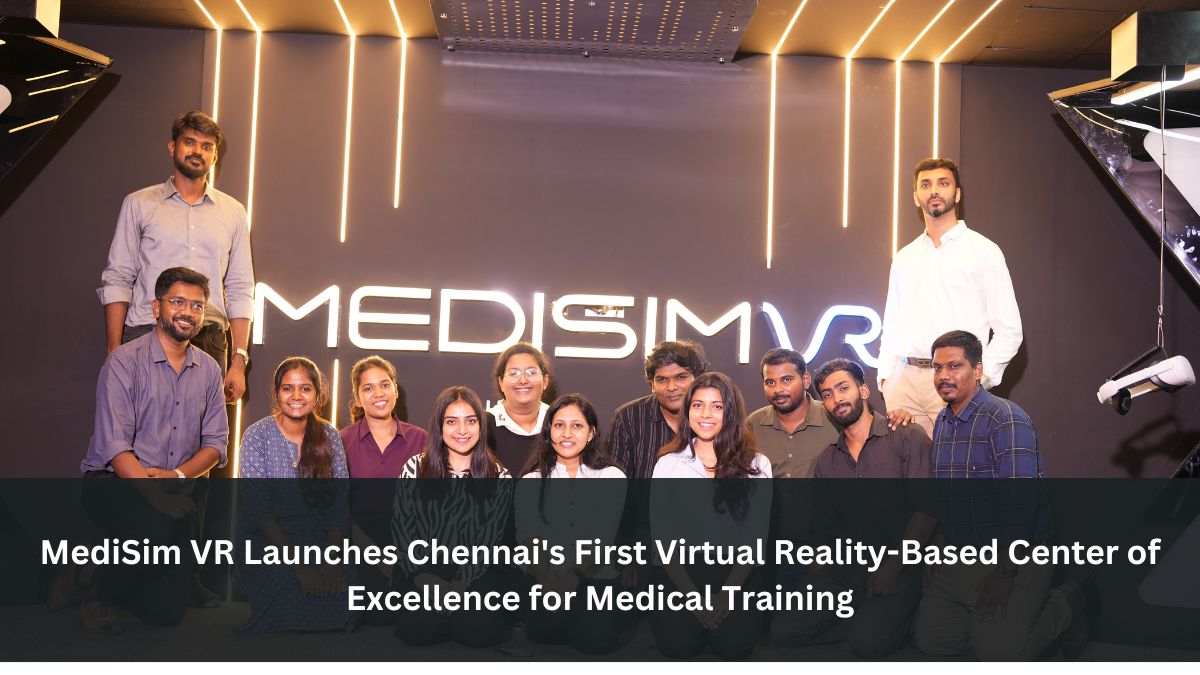Press Release
MediSim VR Launches Chennai’s First Virtual Reality-Based Center of Excellence for Medical Training

Chennai is stepping into the future of medical education with the recent launch of the first-ever Virtual Reality (VR) Center of Excellence (CoE) at Sri Ramachandra Institute of Higher Education and Research (SRIHER). MediSim VR, a pioneering force in healthcare simulation training technology, has spearheaded this initiative, transforming how medical students learn and practice. This article explores the significance of this innovative facility and its potential impact on medical training in India.
A New Era in Medical Education
As healthcare continues to evolve, the need for advanced training methods has never been more pressing. Traditional medical education often struggles to provide students with the hands-on experience necessary to thrive in real-world clinical settings. MediSim VR’s VR lab at SRIHER addresses this gap by offering immersive, interactive training scenarios that prepare future healthcare professionals for the complexities of patient care.
The Benefits of VR in Medical Training
One of the standout features of the MediSim VR lab is its ability to simulate realistic medical scenarios. This allows students to practice critical skills in a safe, controlled environment. According to recent studies, hands-on training can significantly enhance learning outcomes, increasing retention rates and improving procedural competence. A survey conducted by the American Medical Association found that students trained in simulation environments demonstrated a 50% increase in confidence and proficiency compared to those who received traditional instruction (AMA, 2022).
For instance, a student might find themselves in a VR simulation where they must perform a complex surgical procedure. This immersive experience not only helps them hone their technical skills but also builds essential soft skills such as communication and teamwork—crucial elements in the healthcare profession.
Voices from the Leaders
Dr. K. Balaji Singh, the Dean at SRIHER, passionately stated, “We’re dedicated to providing our students with the best medical education possible. Our partnership with MediSim VR merges cutting-edge technology with traditional teaching methods, effectively bridging the gap between theoretical knowledge and practical application.” This holistic approach signifies a shift in medical training paradigms, emphasizing the importance of experiential learning.
Echoing this sentiment, Dr. Adith Chinnaswami, Co-founder of MediSim VR, noted, “We aim to redefine medical education and empower the next generation of healthcare professionals. This facility opens exciting learning opportunities for students from across the nation. By integrating VR-based learning into the curriculum, we set a new standard for medical training that will ultimately enhance patient outcomes.”
Bridging the Gap Between Theory and Practice
The traditional medical curriculum often leaves students feeling disconnected from real-world applications. With the introduction of VR technology, this disconnect is steadily diminishing. Students can now engage in simulated patient interactions, practice surgical procedures, and refine their diagnostic skills—all before stepping into an actual clinical environment.
Furthermore, the flexibility of VR allows for repeat practice. Students can revisit complex scenarios multiple times, enhancing their learning without the pressure of real-life consequences. This method not only boosts competence but also alleviates anxiety, which is often prevalent among medical students facing their first real patients.
Statistics Highlighting the Impact
MediSim VR has already made a significant mark since its inception, benefiting over 4,000 students. This statistic alone underscores the growing recognition of VR training in medical education. According to the National Institutes of Health, simulation training has been shown to reduce medical errors by up to 30%, underscoring the vital role such facilities will play in the future of healthcare (NIH, 2023).
Expanding Access to Medical Training
Located in Chennai, this new CoE is not just for local students; it aims to serve medical trainees from across India. The inclusivity of this initiative will democratize access to high-quality medical training, ensuring that students, regardless of their geographical location, can benefit from state-of-the-art learning tools.
Imagine a medical student from a remote part of the country being able to practice intricate surgical techniques or emergency response scenarios through VR. This opens up a world of possibilities for skill development and fosters a new generation of well-trained medical professionals.
The Future of Medical Training
As technology continues to advance, so too does the landscape of medical education. MediSim VR’s Center of Excellence represents a pivotal moment in this evolution. By integrating VR technology into the learning process, SRIHER is not only enhancing the educational experience but is also ensuring that students are better prepared to meet the challenges of modern healthcare.
Looking Ahead
The implications of this VR initiative extend beyond just technical training. It fosters a culture of continuous learning and adaptation, essential traits for any healthcare professional. As students become more familiar with advanced technologies, they are more likely to embrace innovation throughout their careers, ultimately benefiting patient care.
The launch of MediSim VR’s Center of Excellence at SRIHER is a landmark development in the field of medical education. It offers a promising glimpse into the future of healthcare training, where technology and education intersect to produce competent, confident, and compassionate healthcare professionals.
As we look to the future, it is essential for educational institutions, healthcare providers, and policymakers to support initiatives that integrate advanced technologies into training programs. The potential for improved patient outcomes is immense, and embracing these innovations is not just beneficial—it is imperative. Together, we can revolutionize medical education and ultimately enhance the quality of care provided to patients across the globe.
